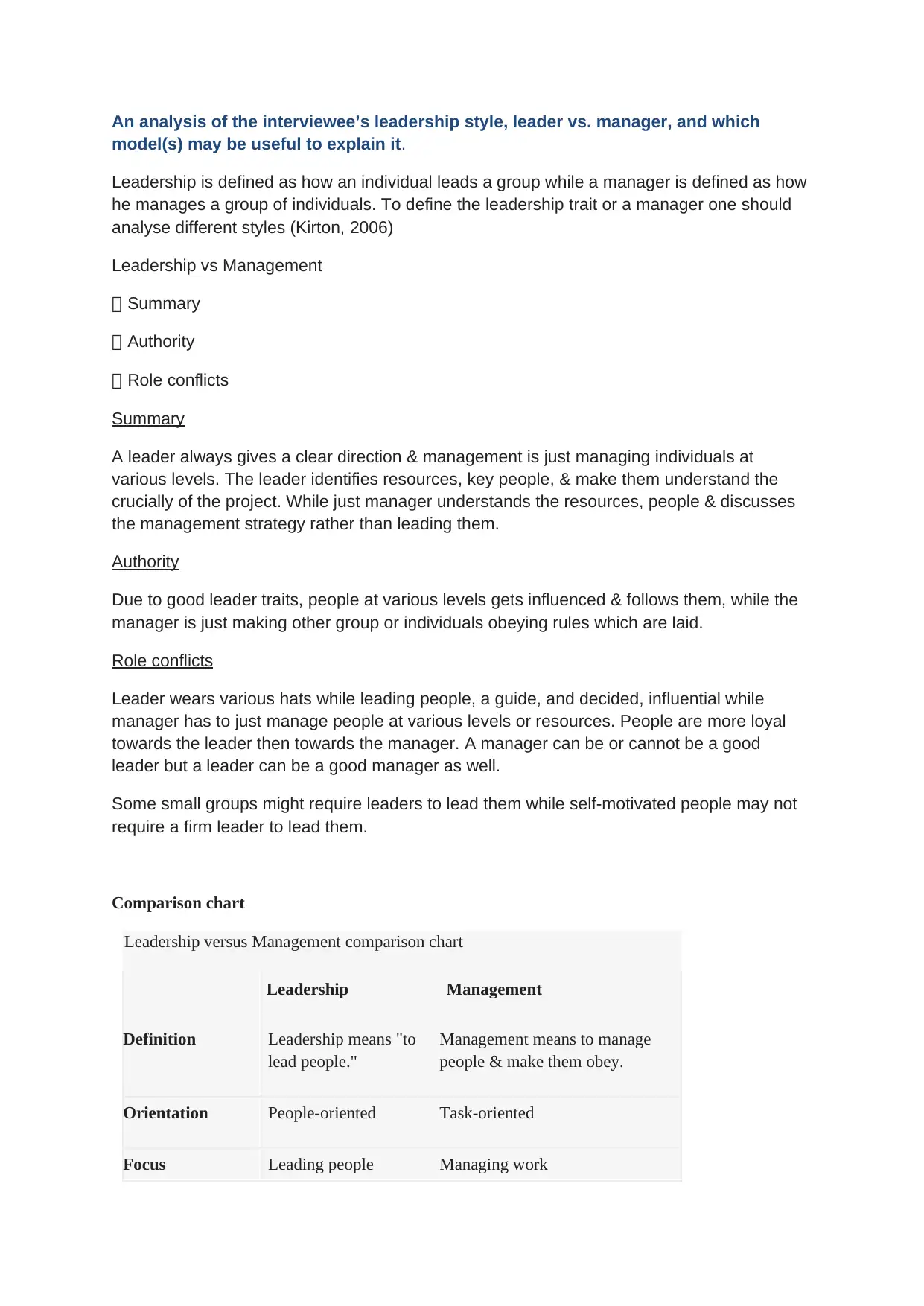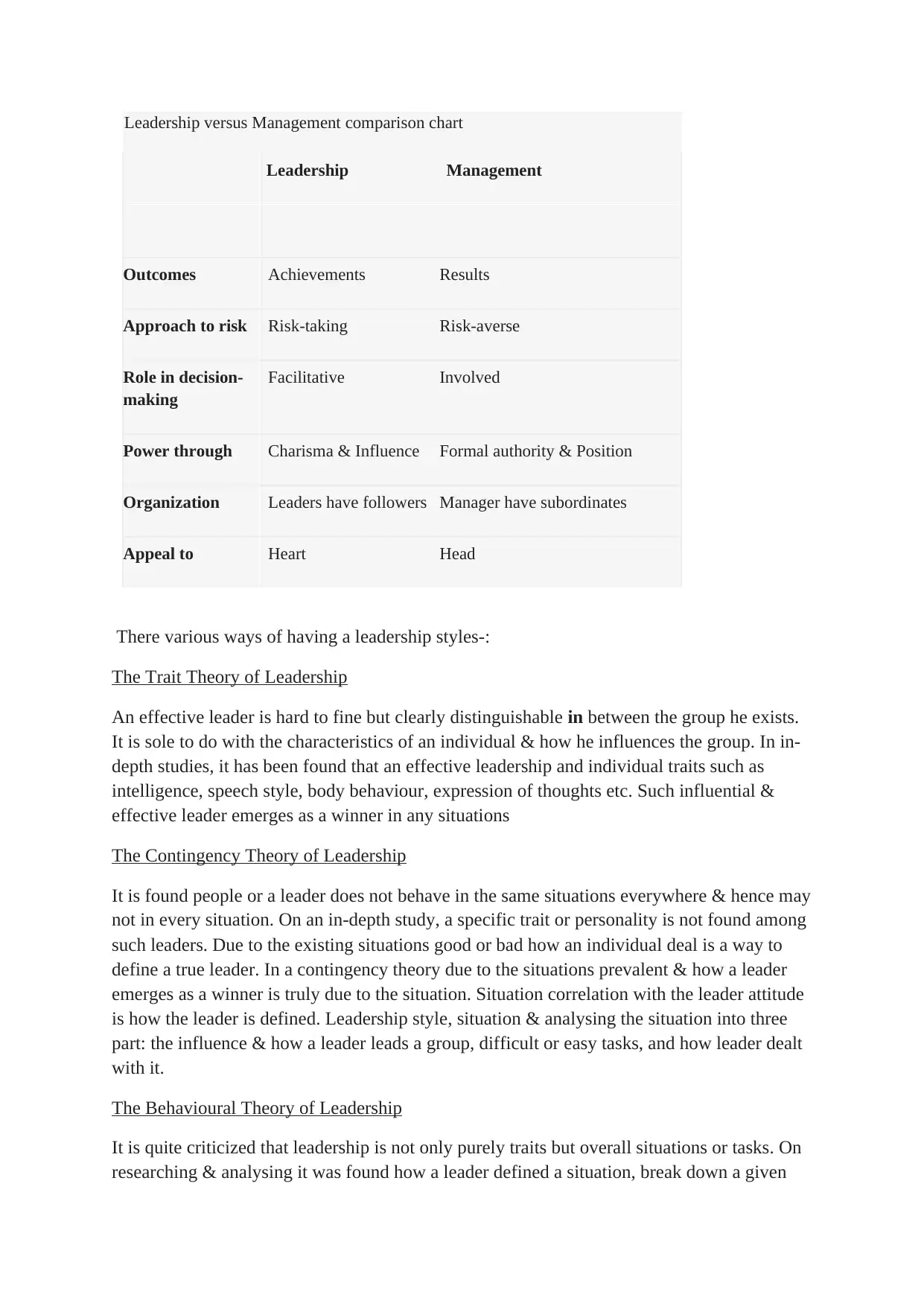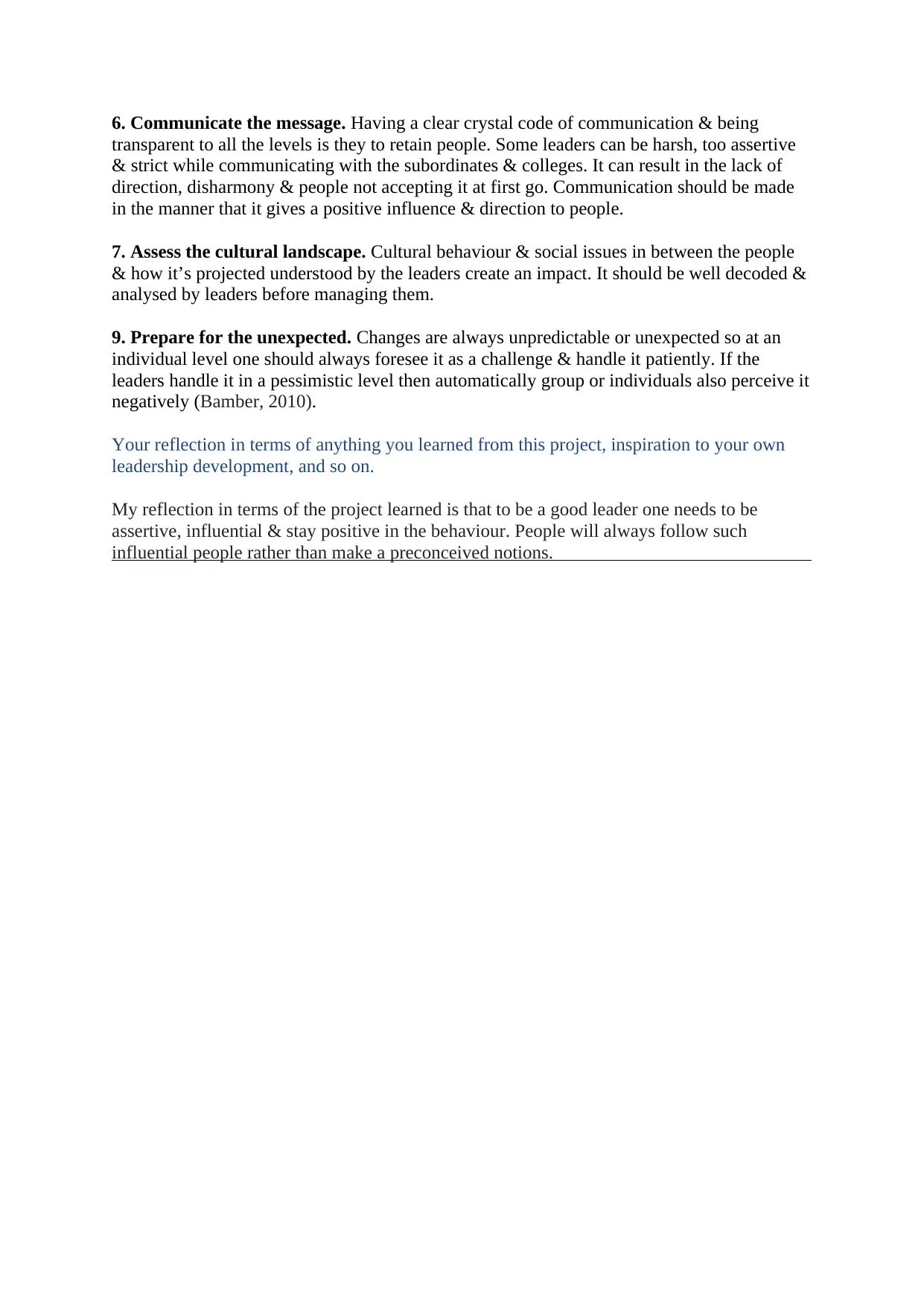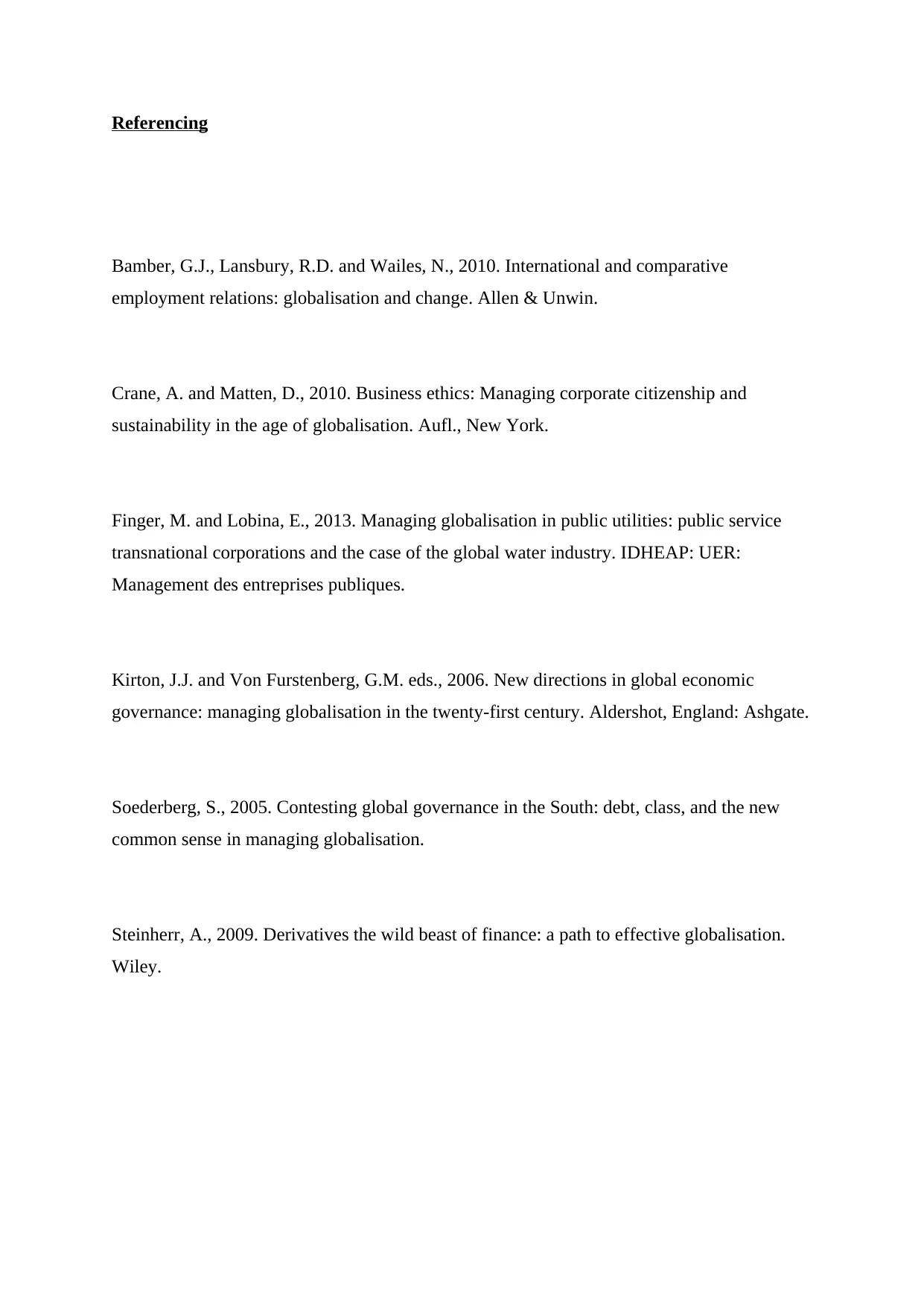Leadership Style Analysis: Models for Leadership and Management
VerifiedAdded on 2019/09/30
|6
|1935
|174
Report
AI Summary
This report provides a comprehensive analysis of leadership styles, differentiating between leaders and managers, and examining various leadership models. The analysis begins with a comparison of leadership and management, highlighting key differences in orientation, focus, and approach. It then delves into several leadership theories, including the Trait Theory, Contingency Theory, Behavioral Theory, and the Full-Range Theory. The report explores the characteristics of each theory, discussing their strengths and weaknesses and providing examples of their application. Furthermore, it examines factors affecting organizational changes and strategies for handling these changes effectively. The report also includes a reflection on the project, emphasizing the importance of assertiveness, influence, and a positive attitude for effective leadership.

An analysis of the interviewee’s leadership style, leader vs. manager, and which
model(s) may be useful to explain it.
Leadership is defined as how an individual leads a group while a manager is defined as how
he manages a group of individuals. To define the leadership trait or a manager one should
analyse different styles (Kirton, 2006)
Leadership vs Management
Summary
Authority
Role conflicts
Summary
A leader always gives a clear direction & management is just managing individuals at
various levels. The leader identifies resources, key people, & make them understand the
crucially of the project. While just manager understands the resources, people & discusses
the management strategy rather than leading them.
Authority
Due to good leader traits, people at various levels gets influenced & follows them, while the
manager is just making other group or individuals obeying rules which are laid.
Role conflicts
Leader wears various hats while leading people, a guide, and decided, influential while
manager has to just manage people at various levels or resources. People are more loyal
towards the leader then towards the manager. A manager can be or cannot be a good
leader but a leader can be a good manager as well.
Some small groups might require leaders to lead them while self-motivated people may not
require a firm leader to lead them.
Comparison chart
Leadership versus Management comparison chart
Leadership Management
Definition Leadership means "to
lead people."
Management means to manage
people & make them obey.
Orientation People-oriented Task-oriented
Focus Leading people Managing work
model(s) may be useful to explain it.
Leadership is defined as how an individual leads a group while a manager is defined as how
he manages a group of individuals. To define the leadership trait or a manager one should
analyse different styles (Kirton, 2006)
Leadership vs Management
Summary
Authority
Role conflicts
Summary
A leader always gives a clear direction & management is just managing individuals at
various levels. The leader identifies resources, key people, & make them understand the
crucially of the project. While just manager understands the resources, people & discusses
the management strategy rather than leading them.
Authority
Due to good leader traits, people at various levels gets influenced & follows them, while the
manager is just making other group or individuals obeying rules which are laid.
Role conflicts
Leader wears various hats while leading people, a guide, and decided, influential while
manager has to just manage people at various levels or resources. People are more loyal
towards the leader then towards the manager. A manager can be or cannot be a good
leader but a leader can be a good manager as well.
Some small groups might require leaders to lead them while self-motivated people may not
require a firm leader to lead them.
Comparison chart
Leadership versus Management comparison chart
Leadership Management
Definition Leadership means "to
lead people."
Management means to manage
people & make them obey.
Orientation People-oriented Task-oriented
Focus Leading people Managing work
Paraphrase This Document
Need a fresh take? Get an instant paraphrase of this document with our AI Paraphraser

Leadership versus Management comparison chart
Leadership Management
Outcomes Achievements Results
Approach to risk Risk-taking Risk-averse
Role in decision-
making
Facilitative Involved
Power through Charisma & Influence Formal authority & Position
Organization Leaders have followers Manager have subordinates
Appeal to Heart Head
There various ways of having a leadership styles-:
The Trait Theory of Leadership
An effective leader is hard to fine but clearly distinguishable in between the group he exists.
It is sole to do with the characteristics of an individual & how he influences the group. In in-
depth studies, it has been found that an effective leadership and individual traits such as
intelligence, speech style, body behaviour, expression of thoughts etc. Such influential &
effective leader emerges as a winner in any situations
The Contingency Theory of Leadership
It is found people or a leader does not behave in the same situations everywhere & hence may
not in every situation. On an in-depth study, a specific trait or personality is not found among
such leaders. Due to the existing situations good or bad how an individual deal is a way to
define a true leader. In a contingency theory due to the situations prevalent & how a leader
emerges as a winner is truly due to the situation. Situation correlation with the leader attitude
is how the leader is defined. Leadership style, situation & analysing the situation into three
part: the influence & how a leader leads a group, difficult or easy tasks, and how leader dealt
with it.
The Behavioural Theory of Leadership
It is quite criticized that leadership is not only purely traits but overall situations or tasks. On
researching & analysing it was found how a leader defined a situation, break down a given
Leadership Management
Outcomes Achievements Results
Approach to risk Risk-taking Risk-averse
Role in decision-
making
Facilitative Involved
Power through Charisma & Influence Formal authority & Position
Organization Leaders have followers Manager have subordinates
Appeal to Heart Head
There various ways of having a leadership styles-:
The Trait Theory of Leadership
An effective leader is hard to fine but clearly distinguishable in between the group he exists.
It is sole to do with the characteristics of an individual & how he influences the group. In in-
depth studies, it has been found that an effective leadership and individual traits such as
intelligence, speech style, body behaviour, expression of thoughts etc. Such influential &
effective leader emerges as a winner in any situations
The Contingency Theory of Leadership
It is found people or a leader does not behave in the same situations everywhere & hence may
not in every situation. On an in-depth study, a specific trait or personality is not found among
such leaders. Due to the existing situations good or bad how an individual deal is a way to
define a true leader. In a contingency theory due to the situations prevalent & how a leader
emerges as a winner is truly due to the situation. Situation correlation with the leader attitude
is how the leader is defined. Leadership style, situation & analysing the situation into three
part: the influence & how a leader leads a group, difficult or easy tasks, and how leader dealt
with it.
The Behavioural Theory of Leadership
It is quite criticized that leadership is not only purely traits but overall situations or tasks. On
researching & analysing it was found how a leader defined a situation, break down a given

tasks & how the group got influenced. B.F. Skinner's founded this theory of Behaviour
Leadership. Hence in a given situation how individual deals with it & how he modifies his
behaviour is a part of Behaviour Theory. Adaptation of behaviour as per a situation.
An example when an employee falls sick or takes an unplanned leave during the crucial
working days how a manager or leader deals with it & convince the sick employee & other
group members is directly proportional to leader behaviour in a given situation.
The Full-Range Theory of Leadership
An employee identification about himself with a given important or normal project is a trait
which is studied in depth in this theory. The four major components of the theory, which
cover the full range of essential qualities of a good leader, are:
· Individualized consideration: how leader values each individual, motivates or listen to
them.
· Intellectual stimulation: conventional ideas & how to remove barriers in a given
situation is planned forecasted by a leader.
· Inspirational motivation: in a situation or in normal life scenario how a leader inspires
others to work removing all the conflicts & smoothening the situation.
· Idealized influence: A leader provides a role model & proving to be highly influential.
A summary of the change made by the leader and an analysis whether the model may explain
factors required for the change
Factors which may affect changes-:
· Due to the prediction dates or forecasting the desired result & how well it contributes to
the success of a business depends on the suitable strategies which are devised. If there are
delays, lags or it's not reaching specific deadlines then we change the style of working
(Finger, 2013).
· External factors such as market volatility, labor frictions, inflows & outflows
investment/money issues can’t be predicted & one should take care of such factors which will
affect our business & there on our planning. Hence always devising an alternative plan
should be thought off & implemented.
· Internally there can be some factors which can affect the smooth functioning of the
organization. Change in executive’s positions or change in senior management's anything can
affect the business & hence change in strategy should be executed.
Leadership. Hence in a given situation how individual deals with it & how he modifies his
behaviour is a part of Behaviour Theory. Adaptation of behaviour as per a situation.
An example when an employee falls sick or takes an unplanned leave during the crucial
working days how a manager or leader deals with it & convince the sick employee & other
group members is directly proportional to leader behaviour in a given situation.
The Full-Range Theory of Leadership
An employee identification about himself with a given important or normal project is a trait
which is studied in depth in this theory. The four major components of the theory, which
cover the full range of essential qualities of a good leader, are:
· Individualized consideration: how leader values each individual, motivates or listen to
them.
· Intellectual stimulation: conventional ideas & how to remove barriers in a given
situation is planned forecasted by a leader.
· Inspirational motivation: in a situation or in normal life scenario how a leader inspires
others to work removing all the conflicts & smoothening the situation.
· Idealized influence: A leader provides a role model & proving to be highly influential.
A summary of the change made by the leader and an analysis whether the model may explain
factors required for the change
Factors which may affect changes-:
· Due to the prediction dates or forecasting the desired result & how well it contributes to
the success of a business depends on the suitable strategies which are devised. If there are
delays, lags or it's not reaching specific deadlines then we change the style of working
(Finger, 2013).
· External factors such as market volatility, labor frictions, inflows & outflows
investment/money issues can’t be predicted & one should take care of such factors which will
affect our business & there on our planning. Hence always devising an alternative plan
should be thought off & implemented.
· Internally there can be some factors which can affect the smooth functioning of the
organization. Change in executive’s positions or change in senior management's anything can
affect the business & hence change in strategy should be executed.
⊘ This is a preview!⊘
Do you want full access?
Subscribe today to unlock all pages.

Trusted by 1+ million students worldwide

· Whenever changes occur during the functionality or due to changes in
management. Transformation may result in chaos & confusions among the workforce. The
way it is dealt at ground level by management should be planned & handled well.
· No same or single strategy can be followed & hence changes to implement alternative
should always be strategies.
Handling the change by the leaders-:
1. Address the “human side” systematically. Address the “human side” systematically.
Any changes or any transformation within the level or in the line of reporting will always
result in the chaos & confusions. Hence it should be handled empathically given the fact it's
affected at individual level & how it creating an impact across various other departments.
Planning & implementation should be well thought off before announcing it. Some groups
should be briefed first & then an official email should be sent to let people know about the
changes or transformation.
2. Start at the top. Every time a change is going to occur good or bad we should start from
hierarchy level. Handling gracefully at the top level & then the information gets dispensed at
other levels. This way information will be disbursed & integrated within the system (Crane,
2010).
Executives at various departments should work adjacently & together to handle such
communication at various levels.
3. Involve every layer. Information which can have a cascading effect on the entire
organization will result in the various hierarchy, departments, staff & people getting affected
due to this. Hence the inclusion of various levels is important while sending out such clear
cut information & should be handled transparently.
4. Make the formal case. Any changes will be outwardly be questioned if the
implementation is doing any justice or is rational in approach. Hence one should be prepared
for the repercussion effects & questions/ confusions which might follow after this.
At every step, one should adhere to 3 rules which firstly, to understand the ground reality
& art of convincing. Secondly, understanding rationality & restoring trust. Finally, designing
an appropriate TAT to on board or designing a new game plan. Accordingly, such messages
will be customized as per the sensitivity of issues.
It needs to be interpreted a Breakeven Point (BEP) & then predicts if the company is
hitting a windfall & reasoning behind it. Once it's decided then strategizing & making an
alternative plan whether to rebrand & again redesign will be easily done.
5. Create ownership. At any levels, creating a sense of belongings or ownership should be
very well implemented & absorbed by the employees. Once the belongings to organization &
towards work is done then it will help in being responsible & accountable towards the task or
work assigned.
management. Transformation may result in chaos & confusions among the workforce. The
way it is dealt at ground level by management should be planned & handled well.
· No same or single strategy can be followed & hence changes to implement alternative
should always be strategies.
Handling the change by the leaders-:
1. Address the “human side” systematically. Address the “human side” systematically.
Any changes or any transformation within the level or in the line of reporting will always
result in the chaos & confusions. Hence it should be handled empathically given the fact it's
affected at individual level & how it creating an impact across various other departments.
Planning & implementation should be well thought off before announcing it. Some groups
should be briefed first & then an official email should be sent to let people know about the
changes or transformation.
2. Start at the top. Every time a change is going to occur good or bad we should start from
hierarchy level. Handling gracefully at the top level & then the information gets dispensed at
other levels. This way information will be disbursed & integrated within the system (Crane,
2010).
Executives at various departments should work adjacently & together to handle such
communication at various levels.
3. Involve every layer. Information which can have a cascading effect on the entire
organization will result in the various hierarchy, departments, staff & people getting affected
due to this. Hence the inclusion of various levels is important while sending out such clear
cut information & should be handled transparently.
4. Make the formal case. Any changes will be outwardly be questioned if the
implementation is doing any justice or is rational in approach. Hence one should be prepared
for the repercussion effects & questions/ confusions which might follow after this.
At every step, one should adhere to 3 rules which firstly, to understand the ground reality
& art of convincing. Secondly, understanding rationality & restoring trust. Finally, designing
an appropriate TAT to on board or designing a new game plan. Accordingly, such messages
will be customized as per the sensitivity of issues.
It needs to be interpreted a Breakeven Point (BEP) & then predicts if the company is
hitting a windfall & reasoning behind it. Once it's decided then strategizing & making an
alternative plan whether to rebrand & again redesign will be easily done.
5. Create ownership. At any levels, creating a sense of belongings or ownership should be
very well implemented & absorbed by the employees. Once the belongings to organization &
towards work is done then it will help in being responsible & accountable towards the task or
work assigned.
Paraphrase This Document
Need a fresh take? Get an instant paraphrase of this document with our AI Paraphraser

6. Communicate the message. Having a clear crystal code of communication & being
transparent to all the levels is they to retain people. Some leaders can be harsh, too assertive
& strict while communicating with the subordinates & colleges. It can result in the lack of
direction, disharmony & people not accepting it at first go. Communication should be made
in the manner that it gives a positive influence & direction to people.
7. Assess the cultural landscape. Cultural behaviour & social issues in between the people
& how it’s projected understood by the leaders create an impact. It should be well decoded &
analysed by leaders before managing them.
9. Prepare for the unexpected. Changes are always unpredictable or unexpected so at an
individual level one should always foresee it as a challenge & handle it patiently. If the
leaders handle it in a pessimistic level then automatically group or individuals also perceive it
negatively (Bamber, 2010).
Your reflection in terms of anything you learned from this project, inspiration to your own
leadership development, and so on.
My reflection in terms of the project learned is that to be a good leader one needs to be
assertive, influential & stay positive in the behaviour. People will always follow such
influential people rather than make a preconceived notions.
transparent to all the levels is they to retain people. Some leaders can be harsh, too assertive
& strict while communicating with the subordinates & colleges. It can result in the lack of
direction, disharmony & people not accepting it at first go. Communication should be made
in the manner that it gives a positive influence & direction to people.
7. Assess the cultural landscape. Cultural behaviour & social issues in between the people
& how it’s projected understood by the leaders create an impact. It should be well decoded &
analysed by leaders before managing them.
9. Prepare for the unexpected. Changes are always unpredictable or unexpected so at an
individual level one should always foresee it as a challenge & handle it patiently. If the
leaders handle it in a pessimistic level then automatically group or individuals also perceive it
negatively (Bamber, 2010).
Your reflection in terms of anything you learned from this project, inspiration to your own
leadership development, and so on.
My reflection in terms of the project learned is that to be a good leader one needs to be
assertive, influential & stay positive in the behaviour. People will always follow such
influential people rather than make a preconceived notions.

Referencing
Bamber, G.J., Lansbury, R.D. and Wailes, N., 2010. International and comparative
employment relations: globalisation and change. Allen & Unwin.
Crane, A. and Matten, D., 2010. Business ethics: Managing corporate citizenship and
sustainability in the age of globalisation. Aufl., New York.
Finger, M. and Lobina, E., 2013. Managing globalisation in public utilities: public service
transnational corporations and the case of the global water industry. IDHEAP: UER:
Management des entreprises publiques.
Kirton, J.J. and Von Furstenberg, G.M. eds., 2006. New directions in global economic
governance: managing globalisation in the twenty-first century. Aldershot, England: Ashgate.
Soederberg, S., 2005. Contesting global governance in the South: debt, class, and the new
common sense in managing globalisation.
Steinherr, A., 2009. Derivatives the wild beast of finance: a path to effective globalisation.
Wiley.
Bamber, G.J., Lansbury, R.D. and Wailes, N., 2010. International and comparative
employment relations: globalisation and change. Allen & Unwin.
Crane, A. and Matten, D., 2010. Business ethics: Managing corporate citizenship and
sustainability in the age of globalisation. Aufl., New York.
Finger, M. and Lobina, E., 2013. Managing globalisation in public utilities: public service
transnational corporations and the case of the global water industry. IDHEAP: UER:
Management des entreprises publiques.
Kirton, J.J. and Von Furstenberg, G.M. eds., 2006. New directions in global economic
governance: managing globalisation in the twenty-first century. Aldershot, England: Ashgate.
Soederberg, S., 2005. Contesting global governance in the South: debt, class, and the new
common sense in managing globalisation.
Steinherr, A., 2009. Derivatives the wild beast of finance: a path to effective globalisation.
Wiley.
⊘ This is a preview!⊘
Do you want full access?
Subscribe today to unlock all pages.

Trusted by 1+ million students worldwide
1 out of 6
Related Documents
Your All-in-One AI-Powered Toolkit for Academic Success.
+13062052269
info@desklib.com
Available 24*7 on WhatsApp / Email
![[object Object]](/_next/static/media/star-bottom.7253800d.svg)
Unlock your academic potential
Copyright © 2020–2025 A2Z Services. All Rights Reserved. Developed and managed by ZUCOL.





